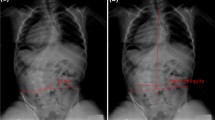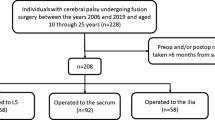Abstract
Study Design
Single institution cohort data were collected prospectively and reviewed retrospectively.
Objectives
This study aims to compare outcomes among three different instrumentation types: unit rod, iliac screws, and sacral alar iliac (SAI) screws in terms of pelvic obliquity correction in children with cerebral palsy (CP).
Summary of Background Data
The optimal choice for spinopelvic fixation in CP scoliosis with pelvic obliquity is controversial.
Methods
Patients with minimum 2 years’ follow-up were divided into three groups according to instrumentation type and matched based on preoperative pelvic obliquity and coronal major curve magnitude. Radiographic measurements included horizontal pelvic obliquity angle (PO), spinopelvic angle (SPA), coronal and sagittal Cobb angles, and T1 pelvic angle. Procedures were performed in one pediatric institution between 2004 and 2012. All measurements were performed by a single independent reviewer who was not involved in the procedures.
Results
Seventy-seven patients (42 unit rod, 14 iliac screw, and 21 SAI screw) were included. Gender and age distribution was similar across all groups (56% males, 44% females, mean age 13.5 years). Mean follow-up was 3.6 years. Comparing pre- and postoperative measurements, there was a significant decrease (p <.05) in PO, SPA, and coronal major cob angle in all groups. No significant loss of correction occurred during follow-up. Postoperatively, TPA improved in all groups. Nonsymptomatic loosening was noted in 59% of unit rods, 57% of iliac screws, and 52% of SAI screws. One prominent iliac screw needed removal. One nonsymptomatic rod fracture, one infected pseudarthrosis, and one rod malposition occurred in unit rod group.
Conclusions
This study suggests that for correction of pelvic obliquity in cerebral palsy scoliosis, iliac and SAI screws were similar to the unit rod in comparative effectiveness and implant safety profile.
Level of evidence
Therapeutic study, Level III.
Similar content being viewed by others
References
Tsirikos AI, Chang WN, Shah SA, et al. Preserving ambulatory potential in pediatric patients with cerebral palsy who undergo spinal fusion using unit rod instrumentation. Spine (Phila Pa 1976) 2003;28:480–3.
Lipton GE, Miller F, Dabney KW, et al. Factors predicting postoperative complications following spinal fusions in children with cerebral palsy. J Spinal Disord 1999;12:197–205.
Tsirikos AI, Mains E. Surgical correction of spinal deformity in patients with cerebral palsy using pedicle screw instrumentation. J Spinal Disord Tech 2012;25:401–8.
Lonstein JE, Akbarnia A. Operative treatment of spinal deformities in patients with cerebral palsy or mental retardation. An analysis of one hundred and seven cases. J Bone Joint Surg Am 1983;65:43–55.
Peelle MW, Lenke LG, Bridwell KH, et al. Comparison of pelvic fixation techniques in neuromuscular spinal deformity correction: Galveston rod versus iliac and lumbosacral screws. Spine (Phila Pa 1976) 2006;31:2392–8.
Sponseller PD, Zimmerman RM, Ko PS, et al. Low profile pelvic fixation with the sacral alar iliac technique in the pediatric population improves results at two-year minimum follow-up. Spine (Phila Pa 1976) 2010;35:1887–92.
Emami A, Deviren V, Berven S, et al. Outcome and complications of long fusions to the sacrum in adult spine deformity: Luque-Galveston, combined iliac and sacral screws, and sacral fixation. Spine (Phila Pa 1976) 2002;27:776–86.
Kebaish KM. Sacropelvic fixation: techniques and complications. Spine (Phila Pa 1976) 2010;35:2245–51.
Myung KS, Lee C, Skaggs DL. Early pelvic fixation failure in neuromuscular scoliosis. J Pediatr Orthop 2015;35:258–65.
Bell DF, Moseley CF, Koreska J. Unit rod segmental spinal instrumentation in the management of patients with progressive neuromuscular spinal deformity. Spine (Phila Pa 1976) 1989;14:1301–7.
Palisano R, Rosenbaum P, Walter S, et al. Development and reliability of a system to classify gross motor function in children with cerebral palsy. Dev Med Child Neurol 1997;39:214–23.
Dayer R, Ouellet JA, Saran N. Pelvic fixation for neuromuscular scoliosis deformity correction. Curr Rev Musculoskelet Med 2012;5:91–101.
Gupta MC, Wijesekera S, Sossan A, et al. Reliability of radiographic parameters in neuromuscular scoliosis. Spine (Phila Pa 1976) 2007;32:691–5.
Osebold WR, Mayfield JK, Winter RB, et al. Surgical treatment of paralytic scoliosis associated with myelomeningocele. J Bone Joint Surg Am 1982;64:841–56.
Abel MF, Blanco JS, Pavlovich L, et al. Asymmetric hip deformity and subluxation in cerebral palsy: an analysis of surgical treatment. J Pediatr Orthop 1999;19:479–85.
Smith RM, Emans JB. Sitting balance in spinal deformity. Spine (Phila Pa 1976) 1992;17:1103–9.
Cobb JR. Outline of the study of scoliosis. American Academy of Orthopedic Surgeons Instructional Course Lectures 1948;5:261–75.
Suh SW, Suh DH, Kim JW, et al. Analysis of sagittal spinopelvic parameters in cerebral palsy. Spine J 2013;13:882–8.
Polly Jr DW, Kilkelly FX, McHale KA, et al. Measurement of lumbar lordosis. Evaluation of intraobserver, interobserver, and technique variability. Spine (Phila Pa 1976) 1996;21:1530–5.
Ryan DJ, Protopsaltis TS, Ames CP, et al. T1 pelvic angle (TPA) effectively evaluates sagittal deformity and assesses radiographical surgical outcomes longitudinally. Spine (Phila Pa 1976) 2014;39:1203–10.
Yazici M, Asher MA, Hardacker JW. The safety and efficacy of Isola-Galveston instrumentation and arthrodesis in the treatment of neuromuscular spinal deformities. J Bone Joint Surg Am 2000;82:524–43.
Maloney WJ, Rinsky LA, Gamble JG. Simultaneous correction of pelvic obliquity, frontal plane, and sagittal plane deformities in neuromuscular scoliosis using a unit rod with segmental sublaminar wires: a preliminary report. J Pediatr Orthop 1990;10:742–9.
Gau YL, Lonstein JE, Winter RB, et al. Luque-Galveston procedure for correction and stabilization of neuromuscular scoliosis and pelvic obliquity: a review of 68 patients. J Spinal Disord 1991;4:399–410.
Author information
Authors and Affiliations
Corresponding author
Additional information
Author Disclosures
OA (none); TN (none); KJR (none); IAB (none); PY (none); SAS (grants from the Setting Scoliosis Straight Foundation, during the conduct of the study; grants from the Setting Scoliosis Straight Foundation, grants and personal fees from DePuy Synthes Spine, Inc., outside the submitted work).
Rights and permissions
About this article
Cite this article
Abousamra, O., Nishnianidze, T., Rogers, K.J. et al. Correction of Pelvic Obliquity After Spinopelvic Fixation in Children With Cerebral Palsy: A Comparison Study With Minimum Two-Year Follow-up. Spine Deform 4, 217–224 (2016). https://doi.org/10.1016/j.jspd.2015.11.001
Received:
Revised:
Accepted:
Published:
Issue Date:
DOI: https://doi.org/10.1016/j.jspd.2015.11.001




